Abstract
A ground-level enhancement (GLE) event is a sudden increase in cosmic ray intensity originated by solar sources and recorded by ground-based detectors. GLEs are invariably associated with large solar flares that can release and accelerate solar particles at high energies. The minimum kinetic energy of particles reaching the Earth’s surface is >433 MeV at sea level and about 300 MeV/n at high-mountain altitude of about 3000 m a.s.l. Even though these abrupt events linked to solar activity are quite rare, they can have a great impact on technological systems and human health when recorded. Therefore, the accurate and effective prognosis of such events is of great importance. In this paper, an overview of the most recently recorded GLE event and the first of solar cycle 25, i.e., GLE73, as well as a post-event analysis is presented. GLE73 was detected on 28 October 2021 and was associated with the active region AR12887 on the central part of the solar disk, which produced an X1.0 solar flare. The event was registered by several stations of the worldwide ground-based neutron monitor network. An accurate alert was issued successfully by the ESA R-ESC federated product GLE Alert Plus, as well as the updated GLE Alert++ System of the Athens Neutron Monitor Station (A.Ne.Mo.S.). It should be emphasized that the GLE Alert++ signal by NKUA/A.Ne.Mo.S. was issued 45 min earlier than the one issued by GOES. A short description and the advantages of this last system are provided.
1. Introduction
A ground-level enhancement (GLE) is defined as an increase in the flux of solar cosmic rays with sufficiently high energies (proton energies above 433 MeV) [1,2]. This sharp increase has a duration of several hours and can be recorded on Earth in the counting rate of ground-based cosmic ray detectors [3,4,5,6].
An earlier and more common definition interprets GLE events as the detection of solar energetic particles by at least two differently located neutron monitors (NMs), as mentioned in [7]. Later, this definition was updated to consider GLEs as a statistically significant increase in the count rate of at least two differently located NMs, accompanied by an increase in data from space-borne instruments. Most recently, [8] stated that “a GLE event is registered when there are near-time coincident and statistically significant enhancements of the count rates of at least two differently located NMs, including at least one NM near sea level and a corresponding enhancement in the proton flux measured by a space-borne instrument(s)”. Moreover, the relatively weak solar energetic particles and events that are recorded only by high-altitude polar NMs and not by stations at sea level can be classified as sub-GLEs.
Phenomena of solar activity, such as solar flares and coronal mass ejections (CMEs) that occur on the Sun, are responsible for the acceleration processes that can accelerate particles up to a few giga-electron volts in kinetic energy. This is sufficient intensity to allow their secondary products to reach the terrestrial surface and be detected by NMs or other particle detectors on Earth [2,5,8].
GLE events are quite rare; the occurrence rate varies with the level of solar activity. Seventy-three such events were registered in the last 80 years. [5,6,9,10]. These events were mostly recorded at regions of polar or high geographic latitude [7], and most frequently appeared during the solar maxima or the solar cycle’s descending phase [11]. The first GLEs were registered with ionization chambers in the 1940s, and neutron monitors were introduced only a few years later, covering solar cycles 17–25 [7,11]. Among all the recorded GLEs, the first event (GLE01) was observed on 28 February 1942 [12], while the last (GLE73) was recorded on 28 October 2021 [2]. During solar cycle 24 (December 2008 to December 2019), only two GLEs were recorded, GLE71 on 17 May 2012 [13,14] and GLE72 on 10 September 2017 [15]; therefore, it was characterized as a quiet solar cycle.
These extreme events may be particularly harmful to technological infrastructure systems, both space-borne and terrestrial [16,17,18]. They may also pose a danger to human health, as far as astronauts and possibly aircrews are concerned [19,20,21,22,23]. For this reason, the forecasting and now casting prognosis of such events is considered highly necessary.
In this work, a short description of the most recent recorded GLE73 on 28 October 2021 is presented, which was the first such event of solar cycle 25, which began in December 2019 and is expected to continue until about 2030 [6]. Moreover, special emphasis is placed on the accurate and timely alert that was successfully issued for this specific event by the ESA Radiation-Expert Service Center (R-ESC) federated product GLE Alert Plus, as well as the updated GLE Alert++ System of the Athens Neutron Monitor Station (A.Ne.Mo.S.). The advantages of this last unique version of GLE Alerts are well-defined.
2. The GLE73 Event
2.1. Observations by Satellites
On 28 October 2021, a major burst of activity was registered on the Sun. As a result, a GLE of cosmic ray intensity, identified as GLE73, was recorded by several stations of the worldwide NM network.
Specifically, on 28 October, 13 flares of classes C, M, and X were registered in the active regions AR12887 and AR12891, including ten C-class flares (C1.1, two C1.2, C1.6, C2.3, three C3.2, C3.3, and C3.9), two M-class flares (M1.4 and M2.2), and one maximum X-class flare (X1.0) [6]. The last is related to the solar proton event that resulted in GLE73. Moreover, the active region AR12887 on 28 October at 15:34 UT (peak time) produced the X1.0 solar flare on the S26W02 part of the solar disk, as well as the resulting proton flux, are presented in Figure 1. This X1.0 solar flare was also detected by the GOES Solar Ultraviolet Imager (SUVI, an extreme ultraviolet telescope that detects photons that are not detectable from the Earth’s surface) [2,6].
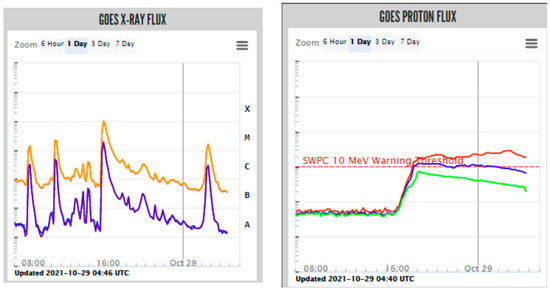
Figure 1.
The X1.0 solar flare (left) and the proton flux as detected by the GOES satellites (right) during the GLE.
The active region AR12887 is located in the central sector of the Sun. Generally, it is not common to have GLEs connected to solar flares to the east of the central meridian, because most solar flares associated with CMEs and GLEs are located in the western or central sectors of the Sun, where the interplanetary magnetic field is well-connected to the Earth’s environment [11].
The aforementioned solar flare was accompanied by an asymmetric halo CME with a linear speed around 1100 km/s, which finally arrived at the Earth on 31 October (Figure 2). The solar energetic particles flux enhancement was recorded by GOES, ACE and Stereo.
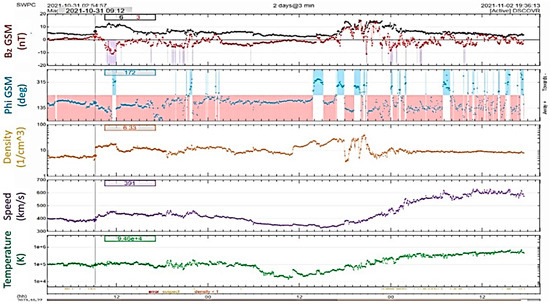
Figure 2.
The associated CME with the X1.0 flare finally arrived at the Earth on 31 October at approximately 09:12 UT (vertical grey line). Solar wind and plasma data were provided by DSCOVR spacecraft.
2.2. Observations by Neutron Monitors
GLE73 was recorded by a total of 13 NM stations around the world (Figure 3a), mostly located in near-polar regions. The characteristics of these NMs are provided in Table 1, which includes the main characteristics of each NM station, such as abbreviation, geomagnetic cutoff rigidity (R), altitude, geographic longitude and latitude, onset time of the GLE73, and finally the percent increase in the cosmic ray intensity registered by each station.
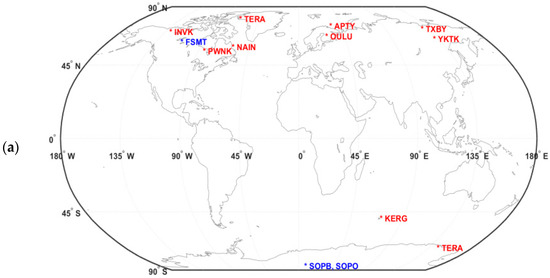
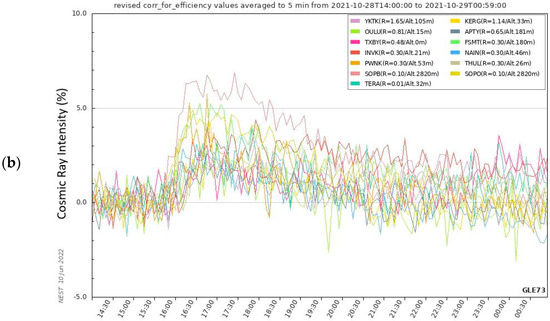
Figure 3.
(a) A map of the NMs that recorded GLE73 (the ones that gave a GLE Alert from ANeMoS in blue) and (b) the perfect increase in the cosmic ray intensity as recorded by these NMs from 28 October, 14:00 UT to 29 October, 00:00 UT.

Table 1.
The thirteen NM stations that recorded GLE73.
The percentage increase in the recorded cosmic ray intensity for each one of the stations is illustrated in Figure 3b, using the online tool NEST of the high-resolution Neutron Monitor Database (NMDB) (http://www1.nmdb.eu (accessed on 28 October 2021)).
2.3. A.Ne.Mo.S. GLE Alert Systems
This GLE event was successfully detected in real time by the GLE Alert Plus and by the updated GLE Alert++ Systems of the Athens Neutron Monitor Station (A.Ne.Mo.S.) (http://cosray.phys.uoa.gr/index.php/glealertplus) (accessed on 28 October 2021). Both systems are available on the ESA SWE portal (https://swe.ssa.esa.int/space-radiation) (accessed on 28 October 2021).
GLE Alert Plus is an improved version of a previous alert system in the frame of ESA SSA P2-VIII project, which has operated since 2013. GLE Alert Plus uses NM data from NMDB and is supported by the NKUA and the European Space Agency (ESA).
The main functionality of GLE Alert Plus is described in the work of Souvatzoglou et al. [5]. After many years of continuous successful operation of GLE Alert Plus, a new and improved version named GLE Alert++ was installed by the Athens Cosmic Ray Group and evaluated by the ESA and is operated on the ESA Website. This system produces a General GLE Alert Graph every minute and station alert graphs for all the stations participating in the network. Although the main core of software of GLE Alert++ remains the same as the previous system, there are significant improvements concerning its software design, web page information provided, as well as its functionality. These improvements are the following:
- The algorithm independently runs for each station without keeping a back-up of the database. In this way, it is faster, creating diagrams for all NM station in only 3–4 s.
- It stores data via SQLite databases, a different one for each day, which is much faster and raises an alert within the same minute the data are available. Thus, this overcomes possible time delays faced by the previous version, which were caused by the one huge SQL database after a few months or years.
- The SQLite database includes important information, such as: (i) the Universal Time (UT) of the GLE Alert++ server; (ii) the value of the measurement, including the station’s day and time; and (iii) the time that the value was recorded from the NMDB database. Therefore, the reproduction of a historical run (for the forthcoming GLE events) with the actual data conditions that were recorded in real time and not with the historical archived data is possible. The previous version also supported such a feature, but this new version continues to provide it in a more convenient way for the user. This is very helpful when one needs to explain the time lag between the General Alert produced based on historical data from NMDB and the General Alert issued based on the actual real time data.
- The webpage design is more user-friendly: users can find as much information as possible about a GLE event. A graph showing the current status of the GLE Alert (Quit, Watch, Warning, or Alert) is displayed in the center of the web page. A summary of the NM stations that are online/offline or no real time is planned to be provided.
- The interface is fully parameterizable, which means that the administrator can: (i) set the parameters of the Station Alert independently for every station; (ii) design a running scenario, trimming all the parameters of the GLE Alert++ system; (iii) decide which stations will be involved in the scenario; and (iv) choose how many stations will trigger a General Alert.
- Based on the knowledge gained by the continuous operation and the real-time detection of the GLE Alert on 10 September 2017, the new graph showing the evolution of alert status is extended to a 2 h duration, instead of the present duration of 1 h. When a GLE Alert is issued, real-time notifications will be distributed to the registered users of the service via email. A report will be issued after the event (within 1 day) and will include the NMs that have recorded the event around the world, onset and maximum flux determination for each station, maximum, time profile, and evolution of the event.
Notably, the new GLE Alert system, as the previous one, requires the availability of selected NMs, providing 1 min resolution data, updated every 1 min. The output is an automated real-time GLE Alert. A graphical web interface denoting the real-time GLE Alert status is implemented and provided to ESA SSA SWE R-ESC.
The GLE Alert++ system of the Athens Neutron Monitor Station (A.Ne.Mo.S.) of the Physics Department at the National and Kapodistrian University of Athens (NKUA) produced a real-time Aaert on October 28 at 16:06 UT based on the NM stations Fort Smith (FSMT) Canada, South Pole Bares (SOPB), Antarctica and South Pole (SOPO), and Antarctica, as shown in Figure 4. As shown in this figure, the web interface of the GLE Alert++ gives valuable information. Firstly, it provides access to the description of the service, the archived GLEs, and the registration service, where users may register for an email notification. Moreover, it provides plots that display the evolution of the General Alert. Finally, it presents the NM stations that contribute to the GLE Alert++, including a notification of their data flow in different colors (Quiet for station alert level 0—green color, Watch for station alert level 1—yellow color, Warning for station alert level 2—orange color, Alert for station alert level 3—red color, Delayed for stations that are nearly real time and send usable minutely data in a predetermined time window—blue color, and Offline for stations that do not send at least one measurement in the above time window—black color) [5].
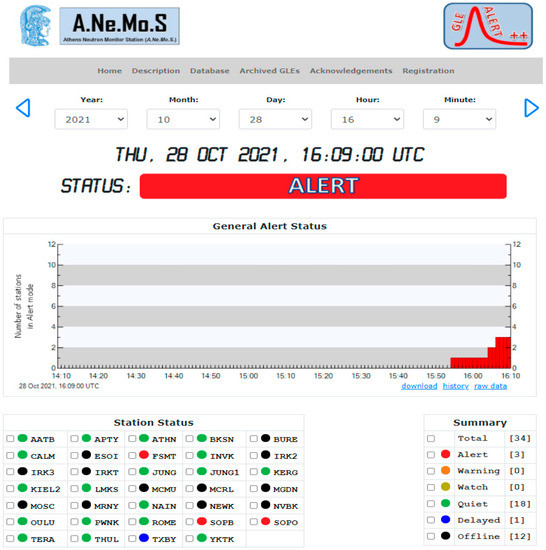
Figure 4.
The GLE Alert++ website of the A.Ne.Mo.S./NKUA at the time of the GLE event recording. Stations FSMT, SOPB, and SOPO triggered the alert and are marked in red in the Station Status table (http://glealertplus.phys.uoa.gr/glealertplus2 (accessed on 28 October 2021)).
Additionally, a graph is included for each NM station (that acts as the seeder of the algorithm), which shows the behavior of the specific NM and reflects its independent climax toward the Station Alert mode. Generally, a particular station enters Station Alert mode when three successive measurements exceed its own threshold and the elapsed time window (presented as a red triangle) is triggered (Figure 5 and Figure 6). Note that the elapsed time is used when a station is in alert mode, and it counts the remaining minutes (starting from the value 15) to return the station to Quiet mode. When at least three stations enter in Station Alert mode according to the above criteria, a general alert is issued by the system.
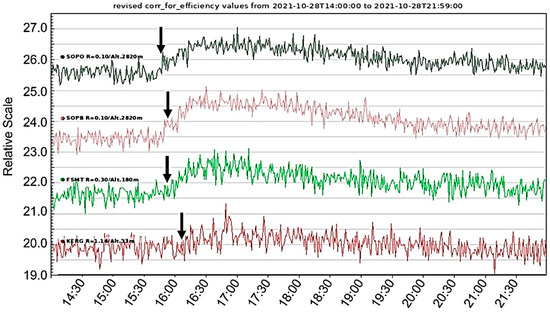
Figure 5.
Cosmic ray intensity at the NM stations detected in real time during GLE73 by the A.Ne.Mo.S. GLE Alert Systems.
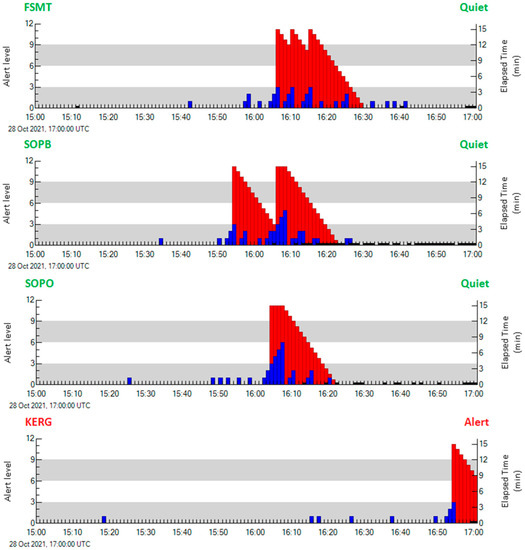
Figure 6.
The evolution of the GLE Alert++ for GLE73.
For GLE73, the SOPB NM status at 15:55 UT was on alert mode, followed by SOPO NM at 16:05 UT and by FSMT NM at 16:06 UT. Later, and while the status of these three NMs was again on “Quiet”, the Kerguelen (KERG), France NM was on alert mode at 16:54 UT. All this information is provided in Figure 6. The alert levels are described in the previous paragraph, and the elapsed time is the remaining time from the start of the station recorded the event till the end of the event. Figure 5 shows the cosmic ray intensity variations for the NM stations that detected GLE73 in real time. In Figure 6, the screenshots of the GLE Alert++ system on 28 October 2021 during the GLE73 for the stations SOPB, SOPO, FRTM, and later KERG in Alert mode are presented.
Finally, the GLE Alert Plus application available on the ESA SWE portal (http://swe.ssa.esa.int/web/guest/space-radiation (accessed on 28 October 2021)), as presented in Figure 7a, produced an email notification that was sent to all subscribed users on 28 October 2021 at 16:09 UT (Figure 7b).

Figure 7.
(a) The GLE Alert Plus application on the ESA SWE portal and (b) the notification via e-mail.
The post-event analysis showed that other NM stations also detected the GLE73 with smaller amplitude, such as Yakutsk (YKTK) Russia, Oulu (OULU) Finland, Apatity (APTY) Russia, Inuvik (INVK) Canada, Nain (NAIN) Canada, Peawanuck (PWNK) Canada, and Terre-Adelie (TERA) Antarctica (Figure 8).
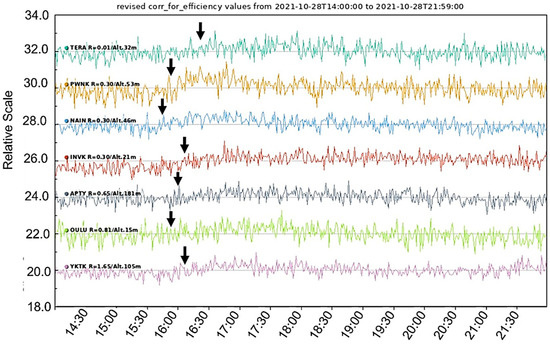
Figure 8.
NM stations that detected GLE73 with small amplitude and did not give alert signal in the A.Ne.Mo.S. GLE Alert Systems.
The relevant Alert of >100 MeV protons and flux >1 pfu from GOES was issued in real time by NOAA on 28 October 2021 at 16:51 UT. The increase in the GOES proton flux (Figure 9) triggered an S1-category solar radiation storm, according to NOAA scales. The GLE Alert++ signal by NKUA/A.Ne.Mo.S. was issued 45 min earlier than the one issued by GOES.
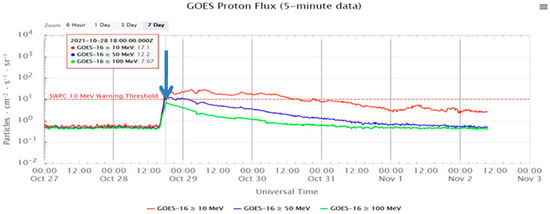
Figure 9.
Alert signal issued by Space Weather Prediction Center (SWPC) of NOAA.
Regarding the Space Weather Reports by the Athens Space Weather Forecasting Center at the A.Ne.Mo.S./NKUA, a minor geomagnetic storm of G1 category was triggered in contrast to the forecasts, where the most probable case was a G3-category storm (Figure 10). One possible explanation is that the major part of the CME traveled below the Sun–Earth line due to the asymmetric shape of the CME. Moreover, the arrival of the CME was successfully forecasted and reported. In particular, the predictions for the time-of-arrival as well as the speed-on-arrival of the CME at 1 AU were performed by utilizing the Effective Acceleration Model (EAM) model [24,25]. According to the output from the last version of the EAMv3 [25] model (Figure 11), the CME should have arrived on 31 October at 04:51 UT with a maximum speed of ~690 km/s. The CME finally arrived just 4 h and 20 min later with a maximum speed of ~470 km/s.
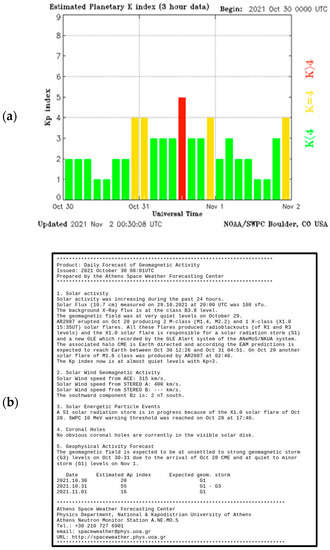
Figure 10.
(a) Kp index variations for 30 October 2021–1 November 2021 and (b) the corresponding Daily Space Weather Forecasting Report from A.Ne.Mo.S. for the same time period.
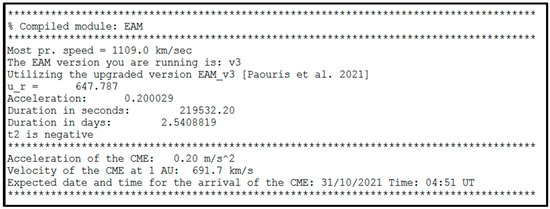
Figure 11.
The report from the Effective Acceleration Model—EAMv3 [25].
3. Conclusions
In summary, it can be claimed that the ESA R-ESC federated product GLE Alert Plus and the updated GLE Alert++ System of the Athens Neutron Monitor Station (A.Ne.Mo.S.) successfully detected GLE73 in real time, which was recorded on 28 October 2021 and the first of such events of solar cycle 25. This GLE was related to an X1.0 solar flare produced in the AR12887 on the central part of the solar disk, and was recorded by several stations of the worldwide ground-based NM network. It should be emphasized that the GLE Alert++ signal by NKUA/A.Ne.Mo.S. was issued 45 min earlier than the one issued by GOES.
The importance of real-time warning systems is clear, and that is why the scientific community welcomes the development and evolving of the GLE Alert systems based on worldwide NM measurements, as they can predict an upcoming GLE event in real time. Thus, major problems of technological infrastructure systems, both space-borne and terrestrial, or even threats for the human health, can be foreseen or even be prevented.
Author Contributions
Conceptualization, H.M. and P.P.; software, P.P.; validation, E.P. and P.P.; formal analysis, E.P. and M.-C.P.; investigation, H.M.; methodology, M.G.; resources, P.P., D.L. and M.L.; data curation, A.N.S. and P.P.; writing—original draft preparation, M.-C.P. and A.T.; writing—review and editing, N.C., M.D., H.M., M.L., M.-C.P. and A.T.; visualization, P.P. and A.N.S.; supervision, H.M.; project administration, M.G. and A.T.; funding acquisition, P.P. All authors have read and agreed to the published version of the manuscript.
Funding
This work received no funding.
Institutional Review Board Statement
Not applicable.
Informed Consent Statement
Not applicable.
Data Availability Statement
The datasets generated and/or analyzed during the current study are available from the corresponding author on reasonable request.
Acknowledgments
This work was supported by ESA SSA SWE Space Radiation Expert Service Centre activities (ESA contract number 4000113187/15/D/MRP). The European Neutron Monitor Services research was funded by the ESA SSA SN IV-3 Tender: RFQ/3-13556/12/D/MRP. The authors would like to thank the cosmic ray data providers of the High-Resolution Neutron Monitor Database (NMDB) that was funded by the European Union. A.Ne.Mo.S was supported by the Special Research Account of Athens University (70/4/5803). E.P. acknowledges support from NASA LWS Grant 80NSSC19K0069.
Conflicts of Interest
The authors declare that there is no conflict of interest.
References
- Souvatzoglou, G.; Mavromichalaki, H.; Sarlanis, C.; Mariatos, G.; Belov, A.; Eroshenko, E.; Yanke, V. Real-time GLE alert in the ANMODAP Center for December 13, 2006. Adv. Space Res. 2009, 43, 728–734. [Google Scholar] [CrossRef]
- Papaioannou, A.; Kouloumvakos, A.; Mishev, A.; Vainio, R.; Usoskin, I.G.; Herbst, K.; Rouillard, A.P.; Anastasiadis, A.; Gieseler, J.; Wimmer–Schweingruber, R.F.; et al. The first ground-level enhancement of solar cycle 25 on 28 October 2021. Astron. Astrophys. 2022, 660, L5. [Google Scholar] [CrossRef]
- Mavromichalaki, H.; Paouris, Ε.; Karalidi, Τ. Cosmic-Ray Modulation: An Empirical Relation with Solar and Heliospheric Parameters. Sol. Phys. 2007, 245, 369–390. [Google Scholar] [CrossRef]
- Anashin, V.; Belov, A.; Eroshenko, E.; Krjakunova, O.; Mavromichalaki, H.; Ishutin, I.; Sarlanis, C.; Souvatsoglou GVashenyuk, E.; Yanke, V. The ALERT signal of ground level enhancements of solar cosmic rays: Physics basis, the ways of realization and development. In Proceedings of the 31st International Cosmic Ray Conference (ICRC), Lodz, Poland, 7–15 July 2009. [Google Scholar]
- Souvatzoglou, G.; Papaioannou, A.; Mavromichalaki, H.; Dimitroulakos, J.; Sarlanis, C. Optimizing the real-time ground level enhancement alert system based on neutron monitor measurements: Introducing GLE Alert Plus. Space Weather 2014, 12, 633–649. [Google Scholar] [CrossRef]
- Velinov, P.I.Y. Major X-class solar flare from earth–Facing active region AR12887 on October 28, 2021 and first cosmic ray GLE73 in solar cycle 25. C. R. Acad. Bulg. Sci. 2022, 75, 2. [Google Scholar] [CrossRef]
- Miroshnichenko, L.I. Retrospective analysis of GLEs and estimates of radiation risks. J. Space Weather Space Clim. 2018, 8, A52. [Google Scholar] [CrossRef] [Green Version]
- Poluianov, S.V.; Usoskin, I.G.; Mishev, A.L.; Shea, M.A.; Smart, D.F. GLE and Sub-GLE Redefinition in the Light of High-Altitude Polar Neutron Monitors. Sol. Phys. 2017, 292, 176. [Google Scholar] [CrossRef] [Green Version]
- Belov, A.V.; Eroshenko, E.A.; Kryakunova, O.N.; Kurt, V.G.; Yanke, V.G. GLEs in the last three solar cycles. In Proceedings of the 31st International Cosmic Ray Conference (ICRC), Lodz, Poland, 7–15 July 2009. [Google Scholar]
- Papaioannou, A.; Mavromichalaki, H.; Gerontidou, M.; Souvatzoglou, G.; Nieminen, P.; Glover, A. Solar particle event analysis using the standard radiation environment monitors: Applying the neutron monitor’s experience. Astrophys. Space Sci. Trans. 2011, 7, 1–5. [Google Scholar] [CrossRef] [Green Version]
- Andriopoulou, M.; Mavromichalaki, H.; Plainaki, C.; Belov, A.; Eroshenko, E. Intense ground level enhancements of solar cosmic rays during the last solar cycles. Sol. Phys. 2011, 269, 155–168. [Google Scholar] [CrossRef]
- Mavromichalaki, H. The Physics of Cosmic Rays Applied to Space Weather. In Advances in Solar and Solar-Terrestrial Physics; Maris, G., Demetrescu, C., Eds.; Research Signpost: Kerala, India, 2012; pp. 135–161. ISBN 978-81-308-0483-5. Available online: http://cosray.phys.uoa.gr/publications/d95.pdf (accessed on 28 October 2021).
- Mishev, A.L.; Kocharov, L.G.; Usoskin, I.G. Analysis of the ground level enhancement on 17 May 2012 using data from the global neutron monitor network. J. Geophys. Res. Space Phys. 2014, 119, 670–679. [Google Scholar] [CrossRef]
- Papaioannou, A.; Souvatzoglou, G.; Paschalis, P.; Gerontidou, M.; Mavromichalaki, H. The first ground level enhancement of solar cycle 24 on 17 May 2012 and its real time detection. Sol. Phys. 2014, 289, 423–436. [Google Scholar] [CrossRef]
- Mavromichalaki, H.; Gerontidou, M.; Paschalis, P.; Paouris, E.; Tezari, A.; Sgouropoulos, C.; Crosby, N.; Dierckxsens, M. Real-Time Detection of the Ground Level Enhancement on 10 September 2017 by A.Ne.Mo.S.: System Report. Space Weather 2018, 16, 1797–1805. [Google Scholar] [CrossRef] [Green Version]
- Daglis, I.A. Effects of Space Weather on Technology Infrastructure. In Proceedings of the NATO ARW on Effects of Space Weather on Technology Infrastructure, Rhodes, Greece, 25–29 March 2003. [Google Scholar]
- Brunetti, G.; McKenzie, I.; Dell’Olio, F.; Armenise, M.N.; Ciminelli, C. Measured radiation effects on InGaAsP/InP ring resonators for space applications. Opt. Express 2019, 27, 24434–24444. [Google Scholar] [CrossRef] [PubMed]
- Makrantoni, P.; Tezari, A.; Stassinakis, A.N.; Paschalis, P.; Gerontidou, M.; Karaiskos, P.; Georgakilas, A.G.; Mavromichalaki, H.; Usoskin, I.G.; Crosby, N.; et al. Estimation of Cosmic-Ray-Induced Atmospheric Ionization and Radiation at Commercial Aviation Flight Altitudes. Appl. Sci. 2022, 12, 5297. [Google Scholar] [CrossRef]
- Bütikofer, R.R.; Flückiger, E.O.; Desorgher, L.; Moser, M.; Pirard, B. The solar cosmic ray ground-level enhancements on 20 January 2005 and 13 December 2006. Adv. Space Res. 2009, 43, 499–503. [Google Scholar] [CrossRef]
- Flückiger, E.; Bütikofer, R. Radiation doses along selected flight profiles during two extreme solar cosmic ray events. ASTRA 2011, 7, 105–109. [Google Scholar]
- Mishev, A.L.; Usoskin, I.G. Assessment of the radiation environment at commercial jet-flight altitudes during GLE 72 on 10 September 2017 using neutron monitor data. Space Weather 2018, 16, 1921–1929. [Google Scholar] [CrossRef] [Green Version]
- Meier, M.M.; Copeland, K.; Kloble, K.E.J.; Matthia, D.; Plettenberg, M.C.; Schennetten, K.; Wirtz, M.; Hellweg, C.E. Radiation in the atmosphere. A hazard to aviation safety? Atmosphere 2020, 11, 1358. [Google Scholar] [CrossRef]
- Tezari, A.; Paschalis, P.; Stassinakis, A.; Mavromichalaki, H.; Karaiskos, P.; Gerontidou, M.; Alexandridis, D.; Kanellakopoulos, A.; Crosby, N.; Dierckxsens, M. Radiation Exposure in the Lower Atmosphere during Different Periods of Solar Activity. Atmosphere 2022, 13, 166. [Google Scholar] [CrossRef]
- Paouris, E.; Mavromichalaki, H. Effective Acceleration Model for the Arrival Time of Interplanetary Shocks driven by Coronal Mass Ejections. Sol. Phys. 2017, 292, 180. [Google Scholar] [CrossRef]
- Paouris, E.; Čalogović, J.; Dumbović, M.; Mays, M.L.; Vourlidas, A.; Papaioannou, A.; Anastasiadis, A.; Balasis, G. Propagating Conditions and the Time of ICME Arrival: A Comparison of the Effective Acceleration Model with ENLIL and DBEM Models. Sol. Phys. 2021, 296, 12. [Google Scholar] [CrossRef]
Publisher’s Note: MDPI stays neutral with regard to jurisdictional claims in published maps and institutional affiliations. |
© 2022 by the authors. Licensee MDPI, Basel, Switzerland. This article is an open access article distributed under the terms and conditions of the Creative Commons Attribution (CC BY) license (https://creativecommons.org/licenses/by/4.0/).